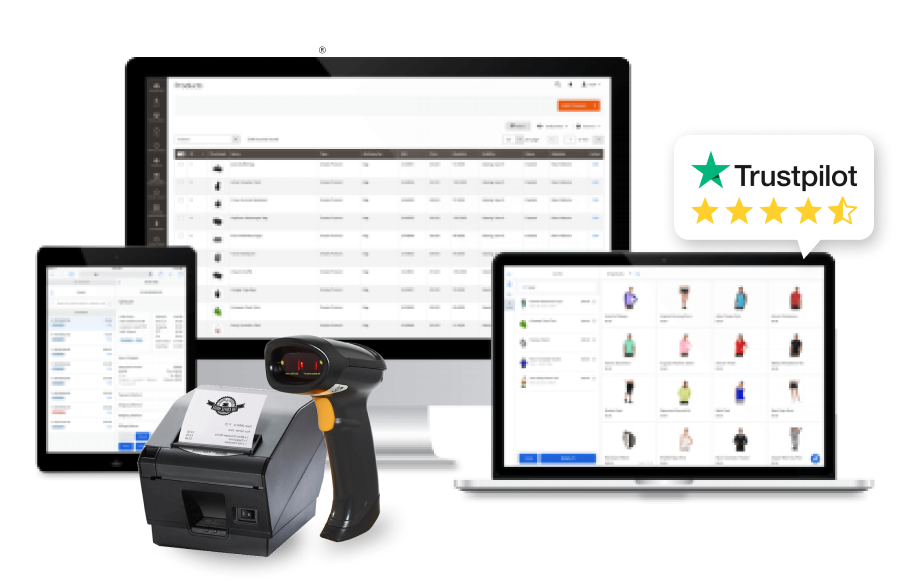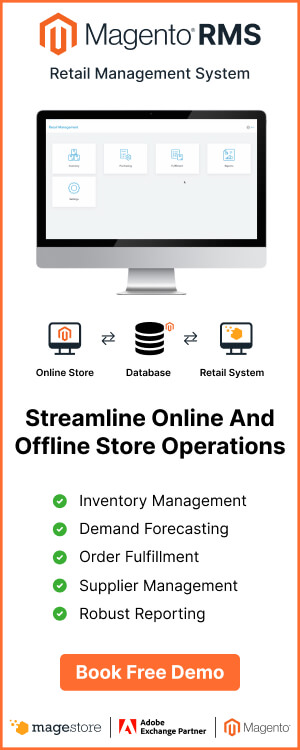Inventory management is one of retailers’ most popular pain points. Which products should I order more in stock and which should I reduce to maximize revenue? If you’re having problems answering these questions, it’s time to consider the 80/20 inventory rule for merchandising. Many retail companies have applied this rule in their inventory control principles and successfully steer their business on the right track. Let’s dive into the question “what is the 80/20 inventory rule?” and how you can implement it to gain advantages over your competitors.
What is the 80/20 inventory rule?

The 80/20 rule, also known as the Pareto Principle, states that 80% of results come from 20% of causes. Therefore, you need to identify and prioritize the 20% of factors that produce the highest outcomes.
In inventory, the rule suggests that 20% of your inventory accounts for 80% of your profit. By applying this principle, you can increase your working capital and align your inventory with customer demand better. It helps you optimize the 20% highest-margin products for volume and profitability.
Although the rule is generally known as 80/20, this isn’t a hard-and-fast mathematical law. For some businesses, it may be 90/10 or 70/30. The overall idea is to focus efforts on the top products to maximize value for your company.
How to classify inventory

There’re various ways to break down your inventory. One of the most common classifications of inventory is to divide the inventory into 4 main types:
Raw materials
Raw materials include direct and indirect materials to make the products. Direct materials are the ingredients that are parts of your final products. For example, eggs to bake cakes, wood to create tables, and silk to manufacture scarves. Indirect materials are consumables during the manufacturing process, such as oil, glue, disposable tools, light bulbs, etc.
Work in progress (WIP)
WIPs are goods that are in progress and need further modification before going to markets, such as flour, fabric, sheets of glass, or window frames.
Finished goods
Finished goods are ready-to-sell items. They’re either consumer goods or intermediate items for another manufacturer, such as bread to a sandwich shop or fabric to a clothing maker.
Maintenance, repair, and operations (MRO)
MRO are items to keep your business functioning, like tools, equipment, or spare parts.
Some business models involve only 1 of the above inventory types, while some manufacturers require all 4. Therefore, you should establish inventory control procedures customized for your business that include all detailed costs and sourcing in one place.
How to categorize inventory

After you’ve understood “what is the 80/20 inventory rule”, you must have a suitable categorization for your inventory. One of the most popular ways is using ABC inventory for your products, in which you divide your products into 3 buckets based on their value and profit:
- A items: Top 20% of your products that result in 70% of sales
- B items: Middle 30% of your products that result in 20% of sales
- C items: Bottom 50% of your products that result in 10% of sales
With this hierarchy, you should prioritize “A” items and make sure they are easily accessible to your customers. These items bring the most profit, thus requiring the tightest control.
“B” items are important, but less essential due to lower sales volume or profitability than “A” items.
“C” items have the least impact on sales with the lowest profit margins.
The ABC inventory rule is great support for the Pareto principle. By using this rule, you can focus on items that are crucial for your business’s success.
The ABC rule helps refine operational processes such as reorder points, lead time, and safety stocks, which ultimately helps businesses control working capital costs and improve inventory turnover rate.
Advantages and disadvantages of the 80/20 inventory control rule
Just like any business tool, the 80/20 inventory has both benefits and drawbacks for inventory management.
Advantages of the 80/20 rule

The greatest benefit of using this rule is that it can help you increase profit and productivity.
Since the metric is based on statistical analysis, it can offer you a repeatable, verified way to control inventory. For example, knowing your 20% low-hanging fruits means you can pay attention and spend resources to make the most out of them. Thus, you can stock up to ensure these top products are always available to customers or train your sales team to focus more on selling them.
On the contrary, when you know your “loser” products and identify bottlenecks, you can start eliminating inventory problems by ordering less or fully removing the items that aren’t selling well.
Similarly, the 80/20 rule suggests that the majority of your sales come from 20% of customers. Identifying the biggest customers enables you to optimize marketing and sales activities on them and create more profits.
Disadvantages of the 80/20 rule

As mentioned above, the 80/20 inventory rule is not a law. It’s a general observation, so it isn’t always accurate.
This is mostly because of natural variations in the split, it could be 70/30 or 60/40. Moreover, it can be misinterpreted as companies may only focus on their 20% and completely neglect the rest. But this is a mistake. Instead, you should combine the rule with the ABC inventory categorization, and seek improvements to bring more items to the “A” level. This way, you reduce the risks of relying on only a few of your products to create high revenue.
Another drawback of the 80/20 inventory rule is that it only applies to past data. It can give you information to control the current stock you have, but doesn’t provide projections for the future, and circumstances can evolve and change. This is where trends reports and insights from the sales team come in. Talking to customers can also give you a better understanding of their needs, so you can plan accordingly for new products.
Combining industry reports and customer insights helps you find out which mid-range products are rising in popularity or have good margins that are worth future investment. In addition, don’t skip your bottom 20% before seeking advice from your sales team. Those less popular items could potentially lead to a winning niche market if you can promote them cleverly.
The 80/20 rule is very useful for inventory control, but it needs to be adopted wisely. Keep a balance between the rule and a business sense for opportunities to ensure your customers are happy with your products and services.
6 tips to implement 80/20 inventory management rule efficiently

With the correct mindset on what is inventory rule, using it doesn’t have to be overwhelming if you have the right tools and processes. Here are some ways to get started:
Implement an inventory management system
First of all, get your business an inventory management software. It can provide necessary insights such as your stock level, cost of goods sold, and sales performance of all SKUs.
For most retailers, using this system helps identify the 20% most profitable inventory and improve your inventory flows. This data can shed light on your next actions:
- For high-value, slow-selling products: Closely monitor inventory items that earn the most profit and make sure they’re always in stock
- For low-value but fast-selling products: Find out the lower-value products that sell easily and keep them as the greater portion of your inventory. In contrast, reduce or remove low-value items that are hard to sell.
If you’re using Magento, Magestore can help you centralize all sales performance data and inventory data, empowering you to make better decisions for your business.
Leverage your top 20% products that sell most and earn most
Your bestseller products and most profitable products may not be the same list. Use your inventory system or ERP system to filter items that have both high sales volumes and strong profits. You can identify a successful product when it meets both requirements. Thus, analyze which SKUs are performing well and have a chance to become the top 20% shortly.
Enhance your inventory process
Once you have your top 20% list, investigate it closely to optimize your inventory processes, such as when to reorder stock to match supply and demand. Inventory control is important to deliver the right products to your customers whenever they want them.
Track the inventory holding costs

Among many benefits of the 80/20 inventory rule, its ability to reduce inventory carrying cost is one of the major applications. This will free you from keeping excess stocks that sell poorly, thus minimizing the capital tied up in the warehouse. With lower holding costs, you can save assets to invest in other aspects of your business that bring more value.
This is where an inventory system can help you gather reliable and timely data to track the costs and give you suggestions to optimize them.
Improve your marketing
When you know the most profitable items, you can spend extra marketing effort for those SKUs. While bestsellers may be fine with the current marketing, the most profitable products outside the 20% should be promoted to increase their sales volume. Next, consider which products in the bottom 20% can be discontinued without affecting customer satisfaction and loyalty.
Monitor and iterate
Remember to continuously monitor the performance of your top product and analyze data to improve your process. Since customers can change their wishes and preferences, you’ll need to adapt your inventory accordingly. Over time, you’ll have a strong and stable inventory management system that allows you to make better decisions.
Related questions
1. What are some examples of the 80/20 rule in business?
- 20% of employees create 80% of sales.
- 20% of customers generate 80% of profits.
- 20% of marketing efforts account for 80% of the results.
- 80% of the inventory problems can be solved by tackling the correct 20% of causes.
2. Who invented the 80/20 rule?
In 1897, Vilfredo Pareto, an Italian economist, observed that 80% of the land in England is owned by 20% of the population. He then creates a theory of predictable imbalance under his name, and this theory has been applied to almost every aspect of modern life.
















